Technology and descriptive choices in the JISC and HEA Open Educational Resources programme.
A position paper for the ADL Learning Content Registries and Repositories Summit by R. John Robertson, Lorna Campbell, Phil Barker
Theme: ‘State of the practice in learning content repositories’ and ‘Systemic Initiatives’ License: CC: BY
JISC and the Higher Education Academy are collaborating on the Open Educational Resources Programme. The Higher Education Funding Council for England (HEFCE) has provided an initial £5.7 million of funding for 29 pilot projects, plus associated support activities, (April 2009 to March 2010) which will explore how to expand the open availability and use of free, high quality online educational resources. (http://www.jisc.ac.uk/oer).
CETIS (the Centre for Educational Technology and Interoperability Standards), a JISC innovation support centre, is providing strategic and technical support for UKOER at both programme and project level. Technical guidance and synthesis is disseminated primarily through the CETIS blogs which are aggregated onto the CETIS website (http://www.cetis.org.uk/).
A different approach
Unlike many previous development programmes, UKOER has not specified a particular technical architecture or mandated a specific approach to metadata and resource description, beyond the requirement that a few key pieces of information are recorded in some way.
The required information is:
- Programme tag
- Title
- Author / owner / contributor
- Date
- URL
- Technical info – file format, name & size.
Some additional information has also been recommended:
- Language
- Subject classifications
- Keywords
- Tags
- Comments
- Descriptions
(http://blogs.cetis.org.uk/lmc/2009/02/03/oer-programme-technical-requirements/)
It is still too early to present a synthesis of how this information has been recorded but it is possible to provide an overview of the platforms, tools, metadata standards and packaging formats that projects have adopted.
Notes
- projects may occur more than once in any given graph.
- the graphs record the number of platforms that support a given format, protocol or standard (rather than use per se)
- the recorded use of Zip is probably unrepresentative
Reflections
- At this stage CETIS technical synthesis of UKOER is still very much a work in progress but some preliminary trends are emerging:
- Unsurprisingly projects have gravitated to technologies they are familiar with and already had in place.
- Projects have used a mixture of elearning platforms, repositories, and innovative approaches
- The standards used are often embedded in applications and their use is dependant on the application chosen.
- The feasibility of aggregating distributed heterogeneous resource descriptions is still unproven.
- The pilot programme points to ways forward to use both web2 applications and digital repositories and to exchange information between them.
- Projects have chosen multiple platforms to support different functions such as preservation, streaming and dissemination, marketing and advocacy.
- Projects’ technical choices primarily reflect resource management and distribution requirements – as opposed to course delivery requirements.
Questions for discussion
- How do these figures fit with your expectations of approaches to sharing learning content?
- Can the applications you are using interact with multiple different platforms and applications for different purposes?
- If relevant, can your content move between different types of platforms? Can your metadata?
A fuller version of this position paper will be presented at the OCWC Conference in May 2010.
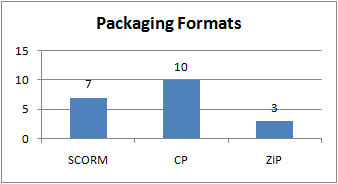
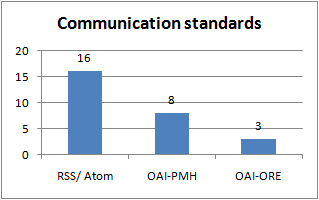
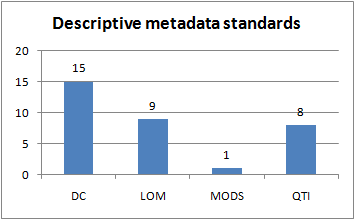
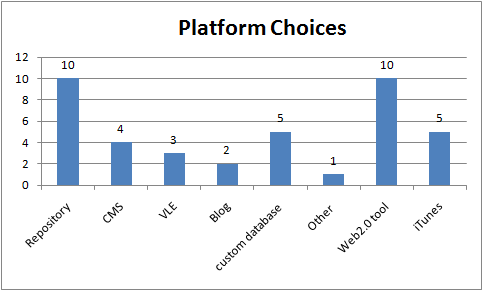
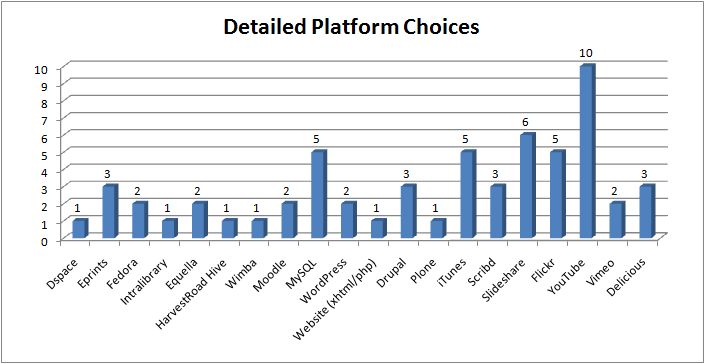
Pingback: Phil’s JISC CETIS blog» Blog Archive » An open and closed case for educational resources
Pingback: Lorna’s JISC CETIS blog » OER 2 Technical Requirements
Pingback: OER Digital Infrastructure Update : Information Environment Team